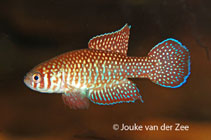| Family: |
Rivulidae (Rivulines), subfamily: Cynolebiinae |
| Max. size: |
2.91 cm SL (male/unsexed); 2.4 cm SL (female) |
| Environment: |
demersal; freshwater |
| Distribution: |
South America: temporary canals of the upper rio Paracatu drainage, rio São Francisco basin in Brazil. |
| Diagnosis: |
Dorsal soft rays (total): 14-19; Anal soft rays: 17-19; Vertebrae: 26-27. Differs from all other species of the subgenus Simpsonichthys by having longitudinal rows of light blue dots on flank in males (vs. absence) and a long filamentous ray on tip of dorsal fin in males, reaching the posterior position of caudal fin (vs. reaching basal portion of caudal fin). Can be differentiated from all congeners by the unique combination of the following characters: pelvic fin present (vs. absent), second pharyngobranchial teeth absent (vs. present), ventral process of posttemporal short (vs. long), 18-19 dorsal-fin rays in males and 14-15 in females (vs. 15-17 in males, 12-13 in females), long filamentous ray on tip of dorsal fin males (vs. filamentous rays short or absent), five alternating bright blue and pink to red bars on head side in males (vs. never a similar color pattern), pectoral fin pink with blue spots in males (vs. hyaline), and absence of black spots on dorsal fin in males (vs. presence of black spots on basal portion of dorsal fin). Caudal fin round (Ref. 58746). |
| Biology: |
Inhabits temporary canals at floodplains (Ref. 58746). |
| IUCN Red List Status: |
Vulnerable (VU); Date assessed: 07 November 2018 (D2) Ref. (130435)
|
| Threat to humans: |
harmless |
Source and more info: www.fishbase.org. For personal, classroom, and other internal use only. Not for publication.
